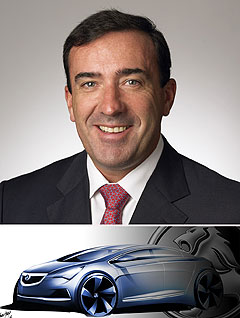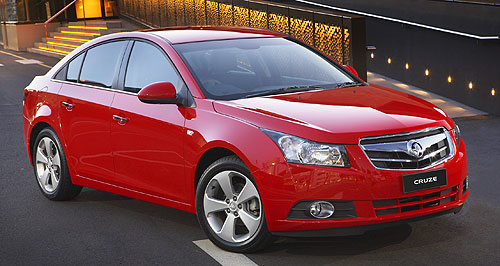Future models - Holden - CruzeHolden’s Aussie Cruze: bold move, big expectationsStep up: Holden has promised that specifications of the locally-built Cruze will be a step up on the current model imported from South Korea. Holden chief urges governments to buy Australian as Cruze production shapes up30 Nov 2009 By TERRY MARTIN GM HOLDEN chairman and managing director Alan Batey has described the company’s decision to build the Cruze small car in Australia as “perhaps the most innovative decision we have ever taken” – but warned there is more “rebuilding” work to be done in the wake of the economic downturn and more support needed from governments in their fleet purchasing policies. Speaking at an ‘Australian automotive review’ hosted by the Committee for Economic Development of Australia (CEDA) in Adelaide on November 20, Mr Batey said the company had learned its lessons from the short-lived (1998-2000) and expensive local production of the Opel/Vauxhall Vectra. He also insisted that exports were not required for the Australian-built Cruze program, which starts in the third quarter of 2010, to be a success. “Perhaps the most innovative decision we have taken is to produce the Cruze small car here in Adelaide – it’s a bold play to return to small-car production but we know it’s right,” he said. “Cruze has been an instant hit in Australia as an imported vehicle and its features and fuel economy are a big part of the mix. “I can tell you the specifications on the local vehicle are going to be another step up.  Left: Holden CEO and Managing Director Alan Batey. Below: Holden's Cruze hatch. Left: Holden CEO and Managing Director Alan Batey. Below: Holden's Cruze hatch.“Small cars have had mixed results for us but we have produced some beauties including Torana and Gemini. The Vectra program in the 1990s gave us valuable learnings and we built the Cruze case on domestic success alone, rather than betting on export markets. “We would certainly love exports but have not staked the program on getting them.” Mr Batey confirmed that Holden took the lead role in the global design of the Cruze hatchback – “it looks stunning” – and that work was progressing on refitting parts of its plant at Elizabeth, South Australia, for both the sedan and hatch. However, in describing Holden’s position in the current financial climate and acknowledging the financial support from the federal government – as well as Holden’s preparedness to provide “unprecedented” depth of detail about its “long-range ambitions” – Mr Batey said more support was needed from state governments in purchasing Australian-made cars, rather than imports. “It might surprise you to know that South Australia and Victoria are the only state governments which have so far bought more locally built cars than imported cars this year,” he said. “Some other jurisdictions are plummeting towards 20 per cent. “It’s much the same in local government which surprises and disappoints me when I look at the ‘source local’ demands many of them make.” Many politicians and government bodies have switched to more fuel-efficient imported cars, and are committing to forthcoming electric vehicles, such as the Mitsubishi i-MiEV. Nissan-Renault documentation acquired by GoAuto also shows the Victorian government has signed a (non-binding) memorandum of understanding with Nissan in August for its 2012 Leaf EV. While Holden is expected to be without a hybrid or a full-electric car on the market until the Volt is imported in 2012, Toyota is about to begin production of the Camry Hybrid at its Altona plant in Victoria, with sales starting early in 2010. “It’s been a big year for Holden on the innovation front (and) we are building a case which methodically removes every possible reason to not buy Australian cars,” said Mr Batey, pointing to the new direct-injection V6 engines in Commodore. “Don’t mistake this for a blind request to buy Australian – we’re simply asking for a fair go. And I’m going to do everything I can to get ministers, mayors and public servants out of foreign cars and back into local product.” Mr Batey said that flow-on effect of not purchasing Australian-made vehicles was also adversely affecting Holden’s suppliers. “A perfect example is tyres. With Bridgestone closing its Salisbury facility by next April, we will be unable to put Australian tyres on our cars,” he said. “The sustainability of suppliers, primarily in South Australia and Victoria, is our biggest concern right now. Aside from declining volumes, there is the vexed issue of access to capital. “It’s not only government funding but good old fashioned commercial finance. So the changing shape of the local supplier footprint makes it hard when we’re trying to locally source as much as possible for Cruze. “We want to be in this together with local suppliers, 100 per cent.” In response, South Australian treasurer Kevin Foley said he would take the message to next week’s (December 7) Council of Australian Governments (COAG) meeting in Queensland. “I intend to raise it informally at least and put a bit of pressure on other states to buy more Australian cars,” he told ABC news. Mr Batey also told the CEDA audience that Holden still needed to “rebuild ourselves as a viable local business”, but said much of that work had already taken place. “GM made it clear we are part of the ‘New GM’ but that comes with responsibilities,” he said. “We have made sure our business is the right size and we are working on the right things, rather than everything. We are a high value-added industry under intense competition. “We know we need to be meaner, leaner and greener. The company which innovates with speed will stay ahead of the curve. He or she who innovates, wins.”  Read more8th of September 2009  Holden on to Cruze monikerHolden will use Cruze name for the 2010 hatch in the wake of the sedan’s strong sale26th of May 2009  Sedan to Cruze it inHolden hopes hatch buyers will not baulk at the sedan-only Cruze31st of March 2009  Inside Holden’s Delta forceCruze hatchback to be first cab off the rank for Holden small-car production31st of March 2009  Holden hatchedGM Holden could not have survived on Commodore alone, says federal industry ministerAll future models Alfa Romeo Alfa Romeo Abarth Abarth Audi Audi Aston Martin Aston Martin BMW BMW Bentley Bentley Chrysler Chrysler Chevrolet Chevrolet Dodge Dodge Citroen Citroen Ferrari Ferrari DS DS Ford Ford Fiat Fiat FPV FPV Foton Foton Haval Haval Great Wall Great Wall Honda Honda Holden Holden Hyundai Hyundai HSV HSV Isuzu Isuzu Infiniti Infiniti Jeep Jeep Jaguar Jaguar Lamborghini Lamborghini Kia Kia Lexus Lexus Land Rover Land Rover Mazda Mazda Maserati Maserati Mercedes-Benz Mercedes-Benz McLaren McLaren Mini Mini Nissan Nissan Mitsubishi Mitsubishi Peugeot Peugeot Opel Opel Proton Proton Porsche Porsche Renault Renault Ram Ram Saab Saab Rolls-Royce Rolls-Royce Smart Smart Skoda Skoda Subaru Subaru SsangYong SsangYong Tesla Tesla Suzuki Suzuki Toyota Toyota Volvo VolvoMotor industry news |
Click to shareHolden modelsResearch Holden All future models Alfa Romeo Alfa Romeo Abarth Abarth Audi Audi Aston Martin Aston Martin BMW BMW Bentley Bentley Chrysler Chrysler Chevrolet Chevrolet Dodge Dodge Citroen Citroen Ferrari Ferrari DS DS Ford Ford Fiat Fiat FPV FPV Foton Foton Haval Haval Great Wall Great Wall Honda Honda Holden Holden Hyundai Hyundai HSV HSV Isuzu Isuzu Infiniti Infiniti Jeep Jeep Jaguar Jaguar Lamborghini Lamborghini Kia Kia Lexus Lexus Land Rover Land Rover Mazda Mazda Maserati Maserati Mercedes-Benz Mercedes-Benz McLaren McLaren Mini Mini Nissan Nissan Mitsubishi Mitsubishi Peugeot Peugeot Opel Opel Proton Proton Porsche Porsche Renault Renault Ram Ram Saab Saab Rolls-Royce Rolls-Royce Smart Smart Skoda Skoda Subaru Subaru SsangYong SsangYong Tesla Tesla Suzuki Suzuki Toyota Toyota Volvo VolvoMotor industry news |
















Facebook Twitter Instagram